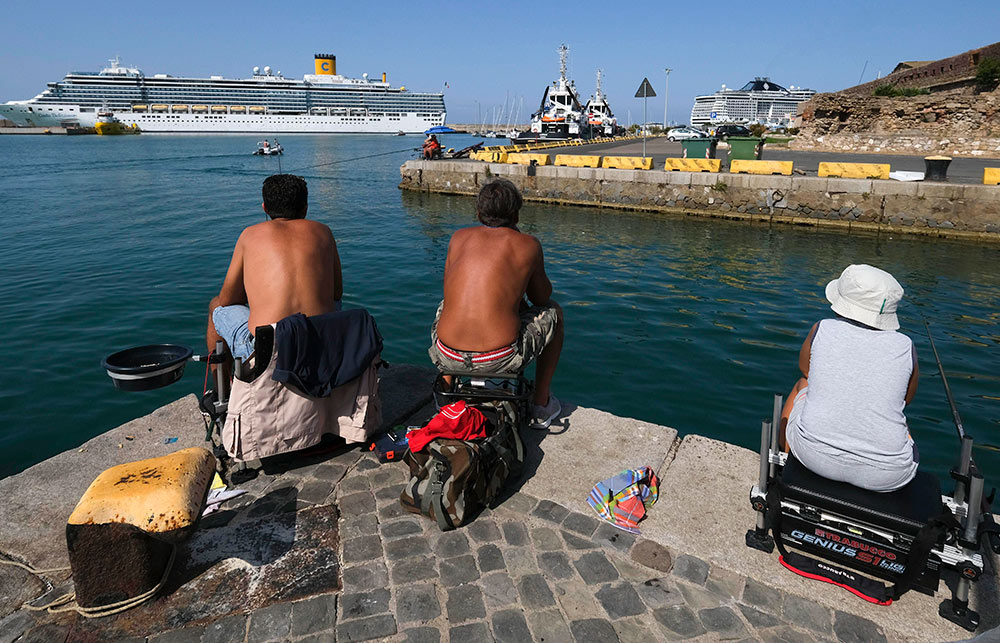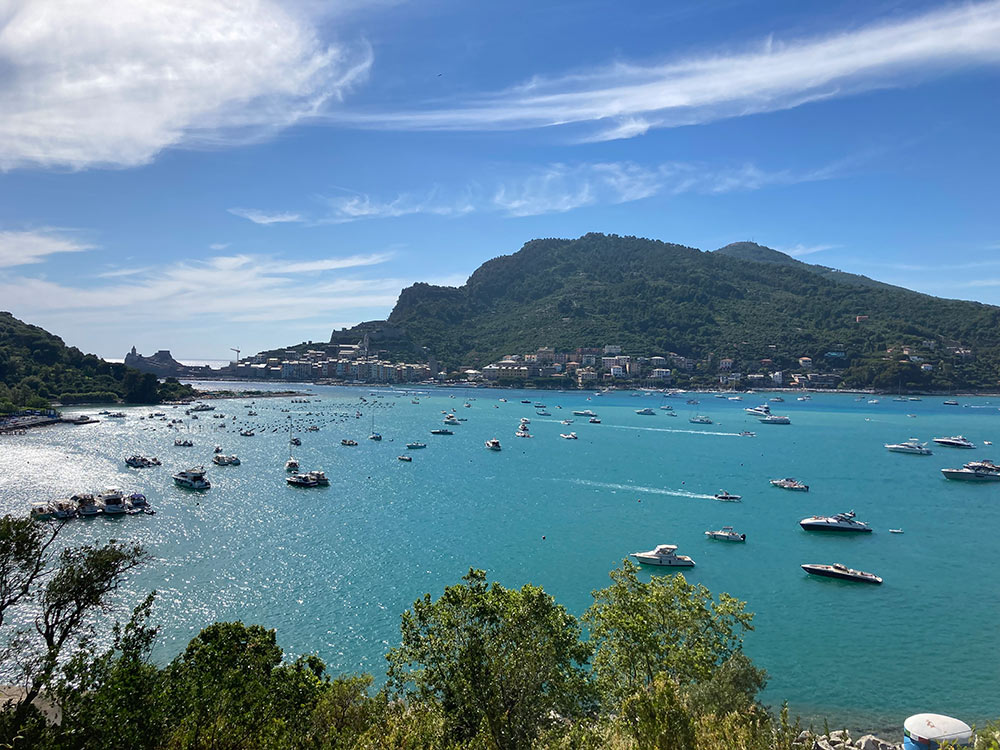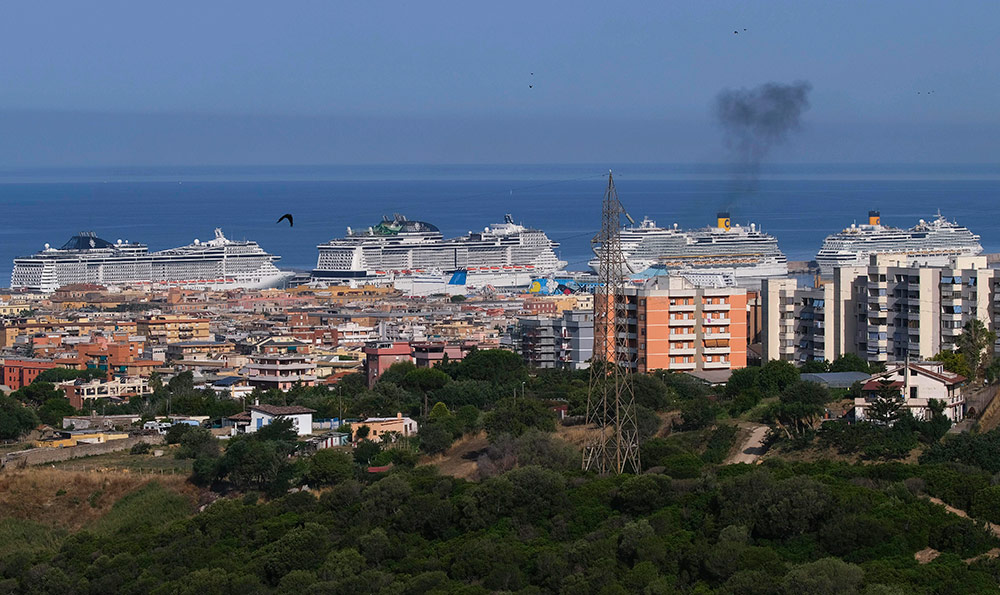
一些意大利人說,如果從港口城市拉斯佩齊亞的山頂俯瞰利古里亞的詩人灣的全景,你就可以飽覽這個國家舉世聞名的美景。幾個世紀以來,這些美景的確吸引了一些世界上最偉大的藝術家。
在你的右手邊,面朝西,屹立在巖石半島的頂端是尖塔聳立的哥特式圣彼得教堂。繼續往前探索,幾個人煙稀少的島嶼映入眼簾。在你的左邊是一排朝東的碼頭和一幢桃紅色的建筑,它們在綿延起伏的綠色山丘的映襯下顯得格外小巧。
這片美景震撼了拜倫——在韋內雷港(聯合國教科文組織世界遺產)有一個半淹沒式的洞穴以他的名字命名——同時查爾斯·狄更斯、珀西和瑪麗·雪萊、D·H·勞倫斯和弗吉尼亞·伍爾夫等人也在此處流連忘返。

然而,在過去的一年半里,有一片新的“風景”出現在人們的視野里:三艘巨大的歌詩達郵輪(Costa Cruises)停靠在海灣中心,發動機在不停運轉,燈也亮著,船上還有一小隊船員。當新冠疫情使從東京到邁阿密的游輪行業陷入困境時,“幽靈船”受到了沉重的打擊。而且它們并不受當地人歡迎。
“它們很煞風景。”塔尼亞·卡倫達告訴《財富》雜志,她是拉斯皮齊亞的藝術策展人,經營著文化機構Sixteen Art & More。“我們美麗的海岸線風景被這些巨大的船只破壞了。在過去一年半的時間里,它們一直在我們的視野里。每個人都受夠了它們的存在。”
“毫無用處的船只”
對游輪運營商來說,過去的18個月令人難忘。
意大利和世界大部分地區的旅游業因為新冠疫情而受到的影響微乎其微。但郵輪行業受到的影響過大,原因是在郵輪狹窄的空間里容易引發疫情,經常與同一個人接觸并且很難隔離潛在的感染者。總而言之,投資者在過去兩年中一直在拋售游輪類股票。
最重要的是,意大利標志性的運河城市威尼斯——世界頂級游輪目的地之一——今年夏天禁止大型船只進入其港口,原因是擔心船只影環境響和破壞城市薄弱的基礎設施。
“旅游業受到了巨大影響。”佛羅倫薩旅游研究中心(Center for Touristic Studies in Florence)的研究主管詹弗蘭科·洛倫佐說,“該行業需要數年時間才能夠恢復到以前的水平。”
根據洛倫佐的說法,在正常情況下,每年游輪在意大利接待1300萬游客。媒體報道稱,盡管今年公司謹慎地重新啟用游輪,但只有大約五分之一的商業游輪在使用,而那些正在使用的游輪的運力遠遠低于容量。
Fincantieri Foundation(意大利芬坎蒂尼歐洲最大的造船商)的海軍歷史學家馬泰奧·馬丁努齊告訴《財富》雜志,游輪運營商唯一遭受類似影響的時期是在兩次世界大戰期間,當時用于跨大西洋和地中海客運的船只,不屬于游船性質,而是作為軍事用船。
馬丁努齊說:“當然,最大的不同是,在戰爭期間,這些船仍然在使用。現在,在大多數情況下,它們已經沒有什么作用可以發揮了。”
遍及整個意大利
毫無用處的船只遠不止在詩人灣停靠。
意大利環保游說團體Legambiente估計,大約有100艘大型游輪停泊在意大利港口或附近地區。據意大利媒體報道,其中地中海郵輪(MSC Cruise)停靠在羅馬主要港口奇維塔韋基亞附近,還有亞得里亞海港口城市里雅斯特、巴勒莫和錫拉丘茲的西西里港口,以及威尼斯。據報道,在詩人灣拋錨的三艘船的所有者歌詩達游輪公司還在熱那亞、奇維塔韋基亞和那不勒斯附近停靠了其他船只。報道還稱,小型游輪公司的船只停靠在布林迪西、卡塔尼亞和利沃諾等旅游目的地附近。
歌詩達郵輪公司沒有回應《財富》雜志的置評請求,地中海郵輪公司的一位發言人拒絕討論這個話題。

據當地新聞報道,這些船只停泊在港口附近的主要為了保持良好的工作狀態,以便能夠迅速為服務做好準備,并為重要船員提供港口服務。
環境保護組織Legambiente Liguria的副總裁斯特凡諾·薩爾蒂表示,這種策略是目光短淺的。他說,停靠的船只不僅破壞了風景,還會對環境造成危害,而且24小時不停地發出噪音。
在夏季的早些時候,他的觀點就得到眾人的支持。到了晚上,游輪的運營者打開燈,把船照得像詩人灣中的圣誕樹一樣閃閃發亮。白天,船長打開巨大的引擎,這艘巨大的船就會故意在水中緩慢地轉個圈。偶爾,船員會對著巨型雕像沮喪地鳴笛,岸上的人會對這種十分奇怪的日常操作十分反感。
薩爾蒂說,Legambiente組織正在考慮發布一份請愿書,要求意大利政府禁止游輪公司在該國最美麗的景點附近停泊船只。
薩爾蒂對《財富》雜志說:“我知道船舶必須停靠在某個地方,但我們必須在船舶運營商的需求和該國的環境保護方面之間取得平衡。解決方案決不可能是把風景優美的港口變成大型游輪的停車場。”(財富中文網)
編譯:於欣
一些意大利人說,如果從港口城市拉斯佩齊亞的山頂俯瞰利古里亞的詩人灣的全景,你就可以飽覽這個國家舉世聞名的美景。幾個世紀以來,這些美景的確吸引了一些世界上最偉大的藝術家。
在你的右手邊,面朝西,屹立在巖石半島的頂端是尖塔聳立的哥特式圣彼得教堂。繼續往前探索,幾個人煙稀少的島嶼映入眼簾。在你的左邊是一排朝東的碼頭和一幢桃紅色的建筑,它們在綿延起伏的綠色山丘的映襯下顯得格外小巧。
這片美景震撼了拜倫——在韋內雷港(聯合國教科文組織世界遺產)有一個半淹沒式的洞穴以他的名字命名——同時查爾斯·狄更斯、珀西和瑪麗·雪萊、D·H·勞倫斯和弗吉尼亞·伍爾夫等人也在此處流連忘返。
然而,在過去的一年半里,有一片新的“風景”出現在人們的視野里:三艘巨大的歌詩達郵輪(Costa Cruises)停靠在海灣中心,發動機在不停運轉,燈也亮著,船上還有一小隊船員。當新冠疫情使從東京到邁阿密的游輪行業陷入困境時,“幽靈船”受到了沉重的打擊。而且它們并不受當地人歡迎。
“它們很煞風景。”塔尼亞·卡倫達告訴《財富》雜志,她是拉斯皮齊亞的藝術策展人,經營著文化機構Sixteen Art & More。“我們美麗的海岸線風景被這些巨大的船只破壞了。在過去一年半的時間里,它們一直在我們的視野里。每個人都受夠了它們的存在。”
“毫無用處的船只”
對游輪運營商來說,過去的18個月令人難忘。
意大利和世界大部分地區的旅游業因為新冠疫情而受到的影響微乎其微。但郵輪行業受到的影響過大,原因是在郵輪狹窄的空間里容易引發疫情,經常與同一個人接觸并且很難隔離潛在的感染者。總而言之,投資者在過去兩年中一直在拋售游輪類股票。
最重要的是,意大利標志性的運河城市威尼斯——世界頂級游輪目的地之一——今年夏天禁止大型船只進入其港口,原因是擔心船只影環境響和破壞城市薄弱的基礎設施。
“旅游業受到了巨大影響。”佛羅倫薩旅游研究中心(Center for Touristic Studies in Florence)的研究主管詹弗蘭科·洛倫佐說,“該行業需要數年時間才能夠恢復到以前的水平。”
根據洛倫佐的說法,在正常情況下,每年游輪在意大利接待1300萬游客。媒體報道稱,盡管今年公司謹慎地重新啟用游輪,但只有大約五分之一的商業游輪在使用,而那些正在使用的游輪的運力遠遠低于容量。
Fincantieri Foundation(意大利芬坎蒂尼歐洲最大的造船商)的海軍歷史學家馬泰奧·馬丁努齊告訴《財富》雜志,游輪運營商唯一遭受類似影響的時期是在兩次世界大戰期間,當時用于跨大西洋和地中海客運的船只,不屬于游船性質,而是作為軍事用船。
馬丁努齊說:“當然,最大的不同是,在戰爭期間,這些船仍然在使用。現在,在大多數情況下,它們已經沒有什么作用可以發揮了。”
遍及整個意大利
毫無用處的船只遠不止在詩人灣停靠。
意大利環保游說團體Legambiente估計,大約有100艘大型游輪停泊在意大利港口或附近地區。據意大利媒體報道,其中地中海郵輪(MSC Cruise)停靠在羅馬主要港口奇維塔韋基亞附近,還有亞得里亞海港口城市里雅斯特、巴勒莫和錫拉丘茲的西西里港口,以及威尼斯。據報道,在詩人灣拋錨的三艘船的所有者歌詩達游輪公司還在熱那亞、奇維塔韋基亞和那不勒斯附近停靠了其他船只。報道還稱,小型游輪公司的船只停靠在布林迪西、卡塔尼亞和利沃諾等旅游目的地附近。
歌詩達郵輪公司沒有回應《財富》雜志的置評請求,地中海郵輪公司的一位發言人拒絕討論這個話題。
據當地新聞報道,這些船只停泊在港口附近的主要為了保持良好的工作狀態,以便能夠迅速為服務做好準備,并為重要船員提供港口服務。
環境保護組織Legambiente Liguria的副總裁斯特凡諾·薩爾蒂表示,這種策略是目光短淺的。他說,停靠的船只不僅破壞了風景,還會對環境造成危害,而且24小時不停地發出噪音。
在夏季的早些時候,他的觀點就得到眾人的支持。到了晚上,游輪的運營者打開燈,把船照得像詩人灣中的圣誕樹一樣閃閃發亮。白天,船長打開巨大的引擎,這艘巨大的船就會故意在水中緩慢地轉個圈。偶爾,船員會對著巨型雕像沮喪地鳴笛,岸上的人會對這種十分奇怪的日常操作十分反感。
薩爾蒂說,Legambiente組織正在考慮發布一份請愿書,要求意大利政府禁止游輪公司在該國最美麗的景點附近停泊船只。
薩爾蒂對《財富》雜志說:“我知道船舶必須停靠在某個地方,但我們必須在船舶運營商的需求和該國的環境保護方面之間取得平衡。解決方案決不可能是把風景優美的港口變成大型游輪的停車場。”(財富中文網)
編譯:於欣
There are some in Italy who say the panorama of Liguria’s Gulf of Poets from atop the hills of the port city of La Spezia might just be the most beautiful spot in a country renowned for breathtaking views. It's certainly stirred some of the world's greatest artists over the centuries.
To the right, facing west, the rocky peninsula is accented at its tip by the sharp-cornered, Gothic Church of St. Peter. Beyond, a few uninhabited islands come into view. To the left, facing east, an array of docks and a peach-colored buildings are dwarfed by the green rolling hills rising up behind them.
This panorama inspired Lord Byron—who has a half-submerged cave named for him in Porto Venere (a UNESCO World Heritage site)—as well as the likes of Charles Dickens, Percy and Mary Shelley, D.H. Lawrence, and Virginia Woolf.
For the last year and a half, though, there’s been a new addition dominating the view: three massive Costa Cruises ships are parked pluck in the center of the gulf, motors running, lights on, and with small crews aboard. The ghost vessels are victims of the dramatic blow that struck the cruise ship industry when the coronavirus pandemic marooned the sector from Tokyo to Miami. And they are not popular with locals.
“They’re an eyesore,” Tania Calenda, a La Spezia-based art curator who runs the culture organization Sixteen Art & More, told Fortune. “We have such a beautiful coastline marred by these massive ships. They’ve been part of our view now for a year and a half. Everyone's tired of having them there.”
“No useful role”
The last 18 months have been ones to forget for cruise ship operators.
The pandemic reduced tourism in Italy, and most of the world, to a trickle. But cruise lines suffered over-sized impacts because of pandemic-related risks connected to cruise ships’ confined spaces, frequent exposure to the same people, and the difficulty of isolating potentially infected individuals. Add it all up, and investors have pounded cruise ship stocks over the past two years.
Then, to top things off, the iconic Italian canal city of Venice—one of the world’s top cruise ship destinations—banned the largest ships from entering its harbor this summer due to worries over environmental impacts and damage to the city’s fragile infrastructure.
“The harm the industry has enormous,” said Gianfranco Lorenzo, head of research at the Center for Touristic Studies in Florence. “It’s going to take years for the sector to recover to previous levels.”
In a normal year, according to Lorenzo, cruise ships would serve 13 million tourists annually in Italy. Media reports say that despite a cautious relaunch this year, only around one in five commercial cruise ships is being used, and those that are in use are operating far below capacity.
Matteo Martinuzzi, a naval historian with the Fincantieri Foundation (Italy-based Fincantieri Europe’s largest shipbuilder), told Fortune that the only period where passenger ship operators suffered similar impacts was during the two World Wars, when ships—then used for trans-Atlantic and Mediterranean passenger transport, not pleasure cruises—were commandeered for military use.
“The big difference, of course, is that during the wars the ships were still being used,” Martinuzzi said. “Now, for the most part, they have no useful role to play.”
All over Italy
The practice of parking out-of-use ships goes far beyond the Gulf of Poets.
Legambiente, an Italian environmental lobby group, estimates that around 100 large cruise ships are parked in or near Italian ports. According to Italian media reports, they include MSC Cruise ships near Civitavecchia, Rome’s main port, the Adriatic port city of Trieste, the Sicilian ports of Palermo and Syracuse, and Venice. Costa, owner of the three ships anchored off the Gulf of Poets, reportedly has other ships parked outside nearby Genoa, at Civitavecchia, and Naples. Ships from smaller cruise companies have reportedly been spotted parked near tourist destinations including Brindisi, Catania, and Livorno.
Costa Cruises did not respond to Fortune’s requests for comment, and a spokesman for MSC Cruises declined to discuss the topic.
According to local news reports, the main reason the ships are parked near ports is to keep them in good working order so they can be quickly made ready for service, and to give the skeleton crews access to port services.
Stefano Sarti, vice president of Legambiente Liguria, says the strategy is short-sighted. In addition to marring picturesque views, he asserts the parked ships cause environmental harm and make noise around the clock.
His complaint was on full view earlier in the summer season. At night, the cruise ship operators flip on the lights, illuminating the vessels like Christmas trees in the middle of the Gulf of Poets. During the day, a captain turns on the massive engines and the enormous ship would make a deliberately slow-go circle in the waters. The occasional boater would deliver a frustrated honk at the colossus, and those on shore would shake their head at the hardly subtle routine maneuver.
Sarti said Legambiente is considering a petition to ask the Italian government to prohibit cruise ship companies from parking their vessels near the country’s most scenic and vulnerable spots.
“I understand that the ships have to be anchored somewhere, but there must be a balance between the needs of the ship operators and the environmental health of some delicate parts of the country,” Sarti told Fortune. “The answer can’t be to turn scenic ports into parking lots for grotesquely large cruise ships.”






